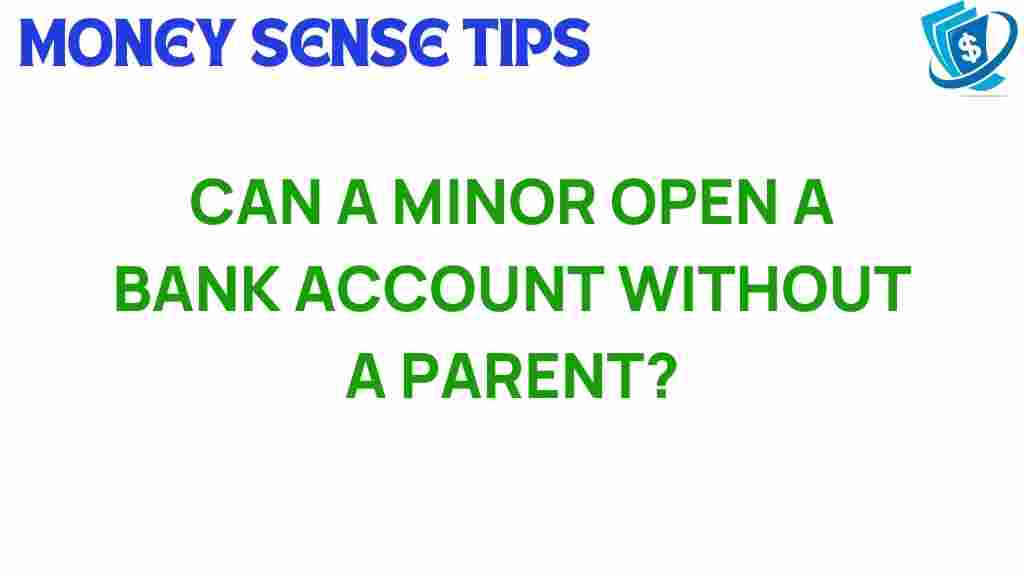Unlocking Financial Independence: Can Minors Open Bank Accounts Alone?
Achieving financial independence is a goal that many individuals aspire to, and the journey often begins in childhood. For minors, understanding the importance of saving, budgeting, and managing money is crucial. One of the first steps in this journey is opening a minor bank account. But can minors really open bank accounts alone? In this article, we will explore the ins and outs of banking for kids, the requirements for underage banking, and how parental consent plays a role in this process.
Understanding Minor Bank Accounts
A minor bank account is specifically designed for individuals under the age of 18. These accounts offer a great way for young people to learn about money management while also enjoying the benefits of banking services. Here are some key features of minor bank accounts:
- Parental Consent: Most banks require parental consent for minors to open an account.
- No Monthly Fees: Many youth savings accounts come with no monthly maintenance fees.
- Educational Tools: Banks often provide resources to help teach financial literacy.
- Withdrawals and Deposits: Minors can usually make deposits and withdrawals, though restrictions may apply.
The Importance of Financial Independence
Financial independence is not just about having money; it’s about understanding how to manage it effectively. For minors, this means learning the basics of financial literacy, such as:
- Budgeting: Understanding how to allocate funds for different needs.
- Savings: The importance of saving for future goals.
- Investing: Basic knowledge of how investments work.
- Spending Wisely: Making informed decisions about purchases.
By managing a teen account, minors can start developing these essential skills early on. Having a bank account can also instill a sense of responsibility, as they learn to track their spending and savings.
How to Open a Minor Bank Account
Opening a bank account for minors is a straightforward process, but it does require certain steps. Here’s how to do it:
Step 1: Research Your Options
Not all banks offer the same features for minor accounts. When looking for a youth savings account, consider the following:
- Interest rates: Look for accounts that offer competitive interest rates on savings.
- Account features: Check for online banking, mobile apps, and educational resources.
- Fees: Ensure there are no hidden fees that could diminish savings.
Step 2: Gather Required Documents
Before visiting the bank, you’ll need to gather some documents. Typically, you will need:
- A valid form of identification for the minor, such as a passport or school ID.
- Social Security number of the minor.
- A form of identification for the parent or guardian, such as a driver’s license.
- Proof of address, which can be a utility bill or a bank statement.
Step 3: Visit the Bank
Once you’ve gathered the necessary documents, visit the bank branch. This is typically a requirement for minors. When you arrive:
- Request to speak with a representative who handles underage banking.
- Present your documents and fill out the account application.
- Discuss any questions regarding account features or parental involvement.
Step 4: Fund the Account
After the account is opened, you may need to deposit an initial amount to activate it. Many banks have a minimum deposit requirement, so be prepared to fund the account accordingly.
Parental Consent: The Role of Guardians
Parental consent is a vital aspect of opening a minor bank account. Banks generally require at least one parent or guardian to co-sign the account. This is to ensure that the adult can oversee the account and provide guidance to the minor.
Some key points to consider about parental consent:
- The parent may have access to the account and the ability to monitor transactions.
- Parents can help teach financial responsibility and literacy to their children.
- In some cases, parents can set limits on withdrawals or spending.
Benefits of Banking for Kids
By opening a bank account during their teenage years, minors can enjoy several benefits:
- Encouraging Savings: Having a bank account encourages minors to save money instead of spending it all.
- Building Financial Skills: Managing an account teaches minors how to handle their finances effectively.
- Access to Financial Tools: Many banks offer tools and resources that can help with budgeting and saving.
Troubleshooting Common Issues
While the process of opening a minor bank account is generally smooth, there can be a few hurdles to overcome. Here are some common issues and how to address them:
Issue 1: Lack of Required Documents
If you arrive at the bank without the necessary documentation, you will not be able to open the account. To avoid this:
- Make a checklist of required documents before your visit.
- Double-check that you have both the minor’s and parent’s identification.
Issue 2: Confusion Over Account Features
Sometimes, the features of youth accounts can be confusing. To clarify:
- Ask the bank representative to explain account features in detail.
- Take notes or request written materials for future reference.
Issue 3: Limited Access to Funds
Minors may face restrictions on how they can access their funds. If this is an issue:
- Discuss with the bank the specific terms of access for minors.
- Consider setting up a plan with parents regarding how funds can be accessed.
Conclusion
In conclusion, opening a minor bank account is a significant step toward achieving financial independence. It empowers young individuals to take control of their finances while learning valuable lessons about saving and budgeting. With the right guidance and parental consent, minors can successfully navigate the world of banking for kids. This early exposure to financial literacy can set the foundation for a lifetime of responsible money management. If you want to explore more about financial literacy resources, consider checking out financial education tools. For more information on banking options, visit your local bank to discuss available accounts for teens.
This article is in the category Accounts and created by MoneySenseTips Team
